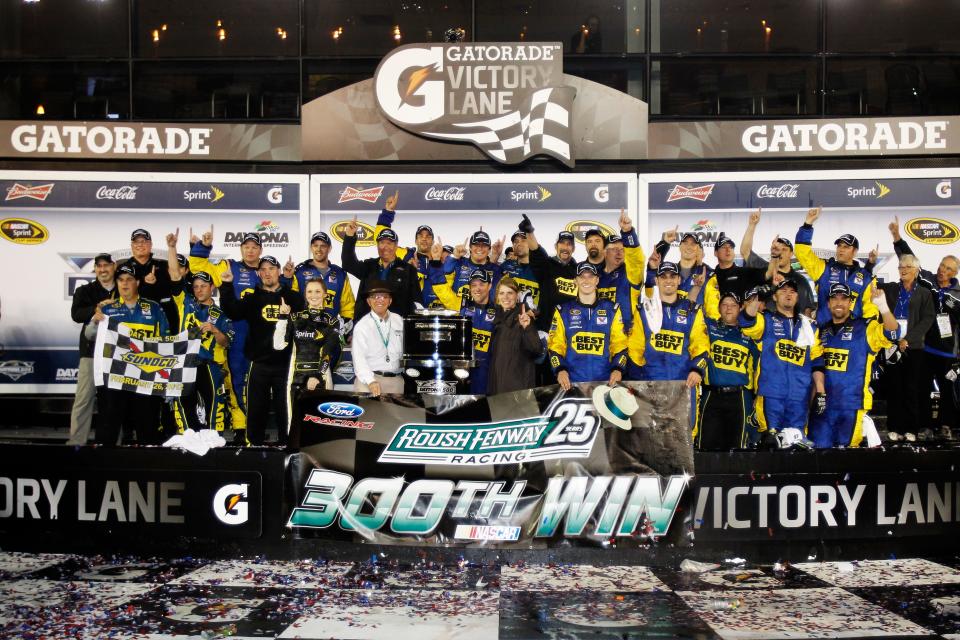Relationships key to Matt Kenseth's NASCAR Hall of Fame journey
CHARLOTTE, N.C. — Champion. Racer. Hall of Famer.
Matt Kenseth is among the last of a defining era in NASCAR Cup Series competition. The final champion of the Winston Cup era, Kenseth also stands as the last driver to claim the title in a season-long format.
And while Kenseth accomplished the sport‘s pinnacle achievement in 2003, it‘s the consistency found by the Cambridge, Wisconsin native over his illustrious career that propelled him into the NASCAR Hall of Fame on Friday as a member of the Class of 2023.
“I don’t really know what I’m doing there,” Kenseth told NASCAR.com Thursday. “You look around the see all the people that have got in before me and how many people are eligible to be put in and I got put in before those people, and so it’s quite overwhelming. So it’s obviously a big honor. It wasn’t something I thought about a lot. Wasn’t really something I thought would really happen, so I‘m gonna try to enjoy here as much as I can.”
RELATED: All Hall of Fame content | Shelmerdine’s rise to HOF
Kenseth‘s humility downplays the significance of his career statistics, which prove Hall-worthy: 39 Cup wins highlighted by two Daytona 500 triumphs, a 47.4% top-10 rate (331 in 697 starts), and 14 victorious seasons split driving for Hall-of-Fame car owners Jack Roush and Joe Gibbs.
But it wasn‘t just what Kenseth accomplished on the track that sealed his fate to join the sport‘s legends in enshrinement. It‘s the relationships he crafted with the men and women who worked on his cars.
Brent Wentz was a mechanic and second spotter for the No. 17 Ford that Kenseth drove from 2008-12. Wentz has worked for a myriad of drivers over a NASCAR career spanning three decades. Kenseth forever tops his list.

“When you work in racing, you want to establish a connection with your driver (and) team,” Wentz said via text. “That makes your job overall better when there is that respect within the team. No one wants to go to work and just be a number.”
That was a mindset Wentz carried to Team Penske, where he worked in the Xfinity Series as a car chief, constantly conscious of encouraging a team atmosphere.
“Matt was that way — practical jokes, talking about football, racing, etc.” Wentz said. “To this day, we have a group chat with a handful of the 17 team members on it. So that should show how close that group was. We won some big races and been through the good (and) bad of the sport together. It‘s great to still have that bond (and) communication.”
Establishing those bonds was second nature for Kenseth, who grew up a short-track racer up north.
“Without all the people that work on the cars, build the parts for the cars, without any of them, obviously you’re not gonna compete,” Kenseth said. “So those are the important people. It’s a people sport, much like other sports are, and without having quality people building your cars, working on your cars, pit crewing your cars, you’re not gonna succeed.”
Along with Wentz, Kenseth earned significant praise from another Hall of Famer, Mark Martin, who played an integral role in getting Kenseth to Roush Racing (now known as RFK Racing).
“His path and what he did reminded me a lot of myself and my path,” Martin said. “How he really first popped up on my radar was winning races in Wisconsin. … I know how hard it is to win there, and Matt was winning, not with one car, not with one team with one great crew chief. He was winning it in multiple different cars with multiple different guys around him.
“That told me that Matt was the one that was making that happen, and that hits home with a lot of guys like Rusty Wallace and myself, who did those same things with our own hands, did our own tires, did our own chassis setups, worked on the cars, put together cars, built cars, and those kind of things.”
Kenseth was meticulous about the details, no matter how old he got and no matter what stage of his career he approached. “If your car was faster than everybody else’s,” he said, “it made your job as a driver a lot easier.”
He loved building his own shocks throughout the week, occasionally utilizing them during practice where “sometimes the stuff was terrible. Sometimes it worked pretty well.
“That was kind of one of my favorite things back in the day was just looking at my cars and trying to figure out how to make them faster than the other guy’s car,” Kenseth said. “I think that still holds true today. I think the cars are closer than ever to being the same right now. But when we moved up to Cup or Busch or whatever I was racing in, I always felt like it was super important just to be as engaged you could possibly be, work with the guys as much as you could and try to be another voice and try to give as much input as you can come up with ideas and try to make this stuff faster.”
That effort was always appreciated and reciprocated by the crewmen who worked on Kenseth‘s cars.
“When people ask me, ‘Who was your favorite driver to work with, it‘s pretty simple: Matt Kenseth is the answer,” Wentz said. “The era of true racers that built (and) maintained and grew up racing their local tracks is slowly going away and so are the drivers that did that. Matt always strived for perfection and we knew that we had to give 110% into anything we did on that 17 team because we knew he was doing the same on (and) off the track.”

